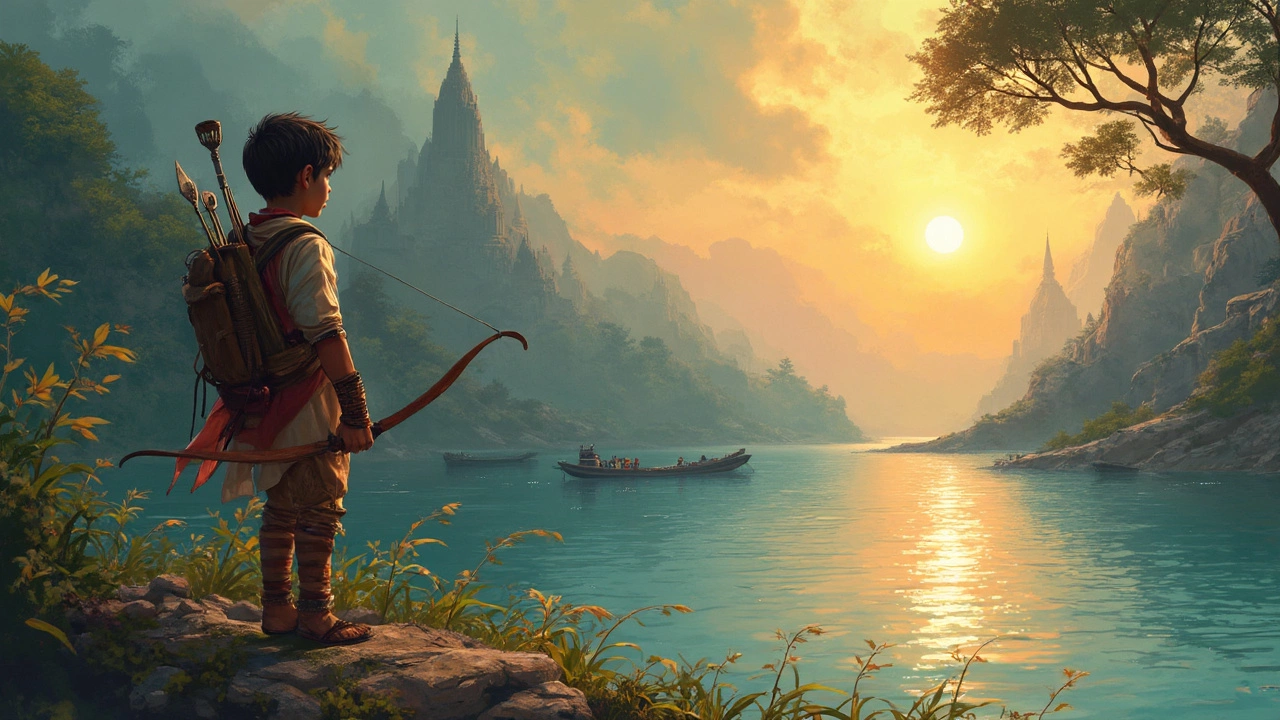Ever stared at a blank page, desperately wishing for inspiration to hit like a lightning bolt? We've all been there. Adventure stories can be like a wild rollercoaster ride of the imagination, but even the most thrilling tales start with a spark. So, if you're itching to dive into a world of excitement and wonder, it all begins with the right prompt.
Picture this: a bustling market in a hidden city deep in the jungle, where every corner holds a secret. What if the map to this place mysteriously appeared in your mailbox one morning? These kinds of scenarios are what get the adventure juices flowing. They're the bread and butter of any gripping tale, setting the stage for the unexpected.
- Setting the Scene
- Character Development
- Plot Twists and Turns
- Time Travel Adventures
- Exploring Unknown Lands
- Mythical Creatures and Legends
Setting the Scene
Every great adventure story kicks off with an unforgettable scene. Think about the vibrant imagery in Indiana Jones or the electric landscapes of Pandora in Avatar. A well-crafted scene doesn't just describe a place—it's a living, breathing world your characters (and readers) can get lost in. So how do you create such an epic backdrop without overloading on flowery prose?
First, anchor your setting in reality. Even the most fantastical worlds have elements that feel familiar. Consider starting with a relatable setting—a small town, a high school, or an office—and weave in layers of the extraordinary. Imagine a sleepy coastal village that suddenly becomes ground zero for time-traveling adventures. Sounds thrilling, right?
An insightful tip is to use the five senses. What's the dominant smell in the air? How does the terrain feel underfoot? Is there a distant noise that hints at something mysterious? By incorporating sensory details, you offer readers an immersive experience.
Also, think about what you can show without telling. Are there peculiar landmarks that suggest a history? How about weather patterns that affect the journey? A rain-soaked jungle is not just wet; it can hint at impending challenges or hidden treasures.
- Start with a familiar setting, then add a twist.
- Use the five senses for a multi-dimensional feel.
- Suggest history or mystery with landmarks and weather.
Remember, it's not just about painting a picture; it's about setting the stage for everything that's going to come next in your adventure stories. The more vivid your setting, the easier it is for your readers to escape reality and dive headfirst into the world you've built.
Character Development
Let's face it: compelling characters can make or break an adventure story. They're the heart and soul of your tale, driving the plot and connecting with readers. So how do you turn an idea into a hero or villain worth rooting for or against?
Start by giving your characters a backstory. Ask yourself, why are they on this wild journey? Maybe your protagonist has always been a fish out of water in their humdrum village, yearning for adventure. Think of Luke Skywalker in 'Star Wars'—that itch to explore something more resonates with us all.
Consider your character’s personality. Are they a fearless daredevil or a cautious thinker? These traits will influence their decisions when the going gets tough. But don't make it black and white; a mix is more relatable. Indiana Jones is courageous but also afraid of snakes. This makes him interesting, doesn't it?
Now, let's talk about adventure stories and how characters evolve. Picture your hero starting off inexperienced and growing into a seasoned adventurer. The best stories showcase personal growth—some might call it a 'hero's journey'. Whether they learn through triumph or failure, evolution is key.
Don't forget the supporting cast. Allies and mentors can be as vital as the villains. Consider how Frodo Baggins, a simple hobbit, had friends and mentors like Gandalf guiding and challenging him. Their interactions can add depth and dimension, helping to drive the plot or even serve up unexpected plot twists.
| Common Character Archetypes | Description |
|---|---|
| The Hero | The one who grows and changes through their journey |
| The Mentor | Guides the hero, often with wisdom and experience |
| The Sidekick | Provides support, sometimes comic relief |
| The Villain | Opposes the hero, creating conflict and tension |
By anchoring your storytelling ideas in well-thought-out characters, you'll craft a narrative that grips readers and leaves them hanging on every word. Happy writing!
Plot Twists and Turns
Plot twists are like the secret sauce that makes adventure stories unforgettable. They keep readers on the edge of their seats, making them turn page after page. If you're crafting an adventure, adding unexpected turns in your plot can give it the zest it needs.
One classic technique is the 'red herring'—leading your readers down one path, only to pull the rug out from under them. It's like setting up a treasure hunt where X never really marks the spot. Give readers clues that seem important but turn out to be misleading. This way, when the real twist hits, it's all the more satisfying.
Incorporating personal stakes can also elevate your story. Your protagonist might think they're just on a journey to find a lost city, but what if it's really about saving their hometown from an impending disaster they were unaware of? This kind of layered storytelling keeps the narrative rich and the readers hooked.
Consider using time constraints. Perhaps your characters have only 24 hours before a magical portal closes forever. Time adds intensity and forces quick decisions, often leading to thrilling twists. How characters cope with these pressures can reveal their true nature, adding depth to your tale.
Don't forget interpersonal plot twists. Allies can become enemies, and competitors might turn into allies when a common threat emerges. These dynamics can add considerable intrigue and emotional depth to your storytelling ideas.
To get a sense of how plot twists can work brilliantly, look at some of the most famous adventure stories, where unexpected alliances and revelations keep the reader engrossed. Pay attention to how and when these twists are revealed—the timing can make all the difference.
- Build suspense—let readers know something's coming without giving too much away.
- Use foreshadowing carefully, hinting at twists without being obvious.
- Make sure the twist is believable within your story's world.
- Ensure the twist advances the story rather than derailing it.
Incorporating well-crafted plot twists turns your adventure from predictable to exhilarating. They're the moments that stay with readers long after they've closed the book, making your tale a journey worth revisiting.

Time Travel Adventures
Time travel adventures spark the wildest dreams. Imagine jumping into a world where you can visit the past or catch a glimpse of the future. This concept has been a hot topic in both literature and movies. Remember "Back to the Future"? Marty McFly changed his destiny with a DeLorean. What would you do if you had access to such power?
When crafting adventure stories with time travel, think about this: What if your character stumbles upon a time machine invented by an eccentric scientist who vanished without a trace? The mystery itself can drive the plot forward. Consider exploring pivotal moments in history or even personal events in your character's life. It’s like mixing fact with fantasy, and it can really anchor readers in your story.
Here are some ideas to keep in mind:
- Butterfly Effect: One tiny change in the past can cause huge ripples in the present. Play with this idea to create tension and stakes.
- Historical Figures: Imagine interacting with famous personalities. How would your character's encounter with them alter their course?
- Alternate Realities: What if your timeline branches into an alternate reality where something major didn’t happen?
Time travel can be both an adventure and a cautionary tale. Here’s a fun fact: The Grandfather Paradox has puzzled many. If you go back and prevent your grandfather from meeting your grandmother, would you even exist to make the trip?
Remember, as you dive into these storytelling ideas, maintaining a coherent logic in your fantasy world is key. Readers love when they can follow how the web of time interlaces, even if only fictional.
Exploring Unknown Lands
Ready to go off the beaten path? Creating adventure stories in uncharted territories is like unwrapping a mystery-filled gift. Unknown lands serve as a blank canvas for your wild imagination, and they add a compelling layer of risk and excitement to your adventure narratives.
The allure of the unknown is hard to resist. Think about legendary explorers like Christopher Columbus or Marco Polo whose journeys have inspired countless tales. Your adventure story could begin with the discovery of an ancient map, hinting at hidden secrets buried in places we've only dreamed of. Or maybe your protagonist stumbles upon an undiscovered island where every creature and plant seems like it's from another world.
Constructing a compelling unknown land involves a few key elements:
- Unique Geography: Design landscapes that defy ordinary logic. Maybe the water runs uphill, or there are floating mountains shrouded in mist.
- Complex Ecosystems: Populate your world with strange animals and vibrant plants that have evolved in isolation. Think of New Zealand's unique species, many of which can't be found anywhere else.
- Secretive Cultures: Create mysterious civilizations thriving in isolation, with customs and technologies completely foreign to the protagonist. Consider societies like the uncontacted tribes in the Amazon, who live with minimal modern interference.
Incorporate these elements to spark curiosity and keep your readers hooked. Leaving some questions unanswered can add to the mystique and allow readers to imagine their own theories about the secrets of these unknown lands.
When writing about unknown places, use them as a tool to challenge your characters. How do they cope when confronted with dilemmas that can't be solved with modern conveniences? This site might even provide a platform for unpredictable plot twists and character growth.
Mythical Creatures and Legends
Alright, let's talk mythical creatures. No adventure story is complete without diving into the rich tapestry of legends and beasts. From ancient folklore to blockbuster movies, these legendary beings capture our imagination like nothing else. We're talking about dragons, unicorns, and phoenixes - the rock stars of the fantasy world.
Let's kick things off with dragons. They're the epitome of adventure, often portrayed as fierce and fiery, guarding treasure in secret caves. Ever heard of Smaug from 'The Hobbit'? Yeah, that giant, gold-loving lizard sets the standard. Writers have explored dragons in various cultures, including the wise, serpent-like dragons in Chinese mythology. So, they're not just Western marvels!
Now, unicorns might sound a bit more peaceful, but don't be fooled. These creatures date back to ancient civilizations, sneakily appearing in Mesopotamian art and even in the natural history works of Aristotle and Pliny the Elder. They symbolize purity and grace but throw them into your story, and they can become mysterious guides or pivotal peacekeepers.
Then we've got phoenixes - the ultimate comeback kings. Rising from their ashes, these birds are all about rebirth and renewal. Ancient Egyptians were on this bird's fan list, associating it with immortality. Just imagine writing a character that gains wisdom every time they 'reincarnate'. Sounds cool, right?
Every culture is packed with different mythical creatures and stories. When crafting adventure stories, weaving in these beings can add layers to your plot. They'll entice readers because who doesn't love a bit of fantasy in their adventure? Next time you're plotting your story, think about which creature best suits your tale. Maybe your hero needs a wise dragon mentor or a unicorn to show them the way. Whatever you choose, these legends are sure to spice things up!

